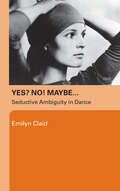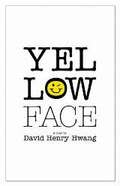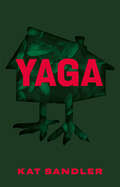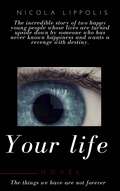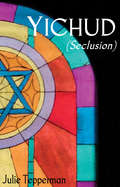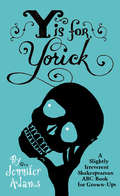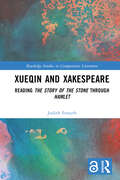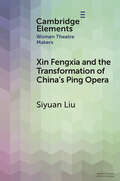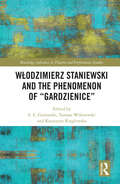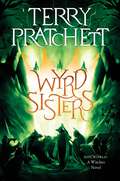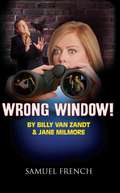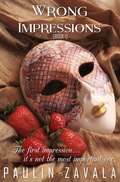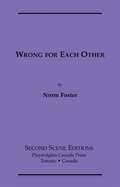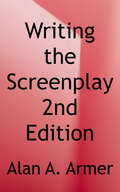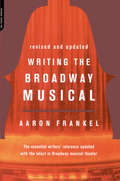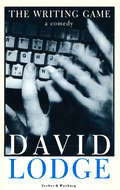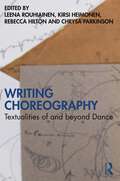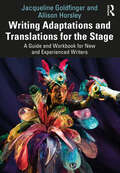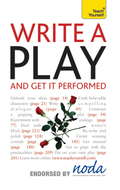- Table View
- List View
Yes? No! Maybe…: Seductive Ambiguity in Dance
by Emilyn ClaidCovering fifty years of British dance, from Margot Fonteyn to innovative contemporary practitioners such as Wendy Houstoun and Nigel Charnock, Yes? No! Maybe is an innovative approach to performing and watching dance. Emilyn Claid brings her life experience and interweaves it with academic theory and historical narrative to create a dynamic approach to dance writing. Using the 1970s revolution of new dance as a hinge, Claid looks back to ballet and forward to British independent dance which is new dance’s legacy. She explores the shifts in performer-spectator relationships, and investigates questions of subjectivity, absence and presence, identity, gender, race and desire using psychoanalytical, feminist, postmodern, post-structuralist and queer theoretical perspectives. Artists and practitioners, professional performers, teachers, choreographers and theatre-goers will all find this book an informative and insightful read.
Yellow Face
by Frank Rich David Henry Hwang"A pungent play of ideas with a big heart. Yellow Face brings to the national discussion about race a sense of humor a mile wide, an even-handed treatment and a hopeful, healing vision of a world that could be."--Variety"Charming, touching, and cunningly organized as well as funny, [with] an Ibsenite reach and stature far beyond any issues of Hwang's self-image."--The Village Voice"It's about our country, about public image, about face," says David Henry Hwang about his latest work, a mock documentary that puts Hwang himself center stage as it explores both Asian identity as well as race in America. The play begins with the 1990s controversy over color-blind casting for Miss Saigon, before it spins into a comic fantasy, in which the character DHH pens a play in protest and then unwittingly casts a white actor as the Asian lead. Yellow Face also explores the real-life investigation of Hwang's father, the first Asian American to own a federally chartered bank, and the espionage charges against physicist Wen Ho Lee. Adroitly combining the light touch of comedy with weighty political and emotional issues, "Hwang's lively and provocative cultural self-portrait lets nobody off the hook" (The New York Times).David Henry Hwang is the author of the Tony Award-winning M. Butterfly, a finalist for the 1988 Pulitzer Prize. Other plays include Golden Child, FOB, The Dance and the Railroad, and Family Devotions; his opera libretti include three works for composer Philip Glass. He was appointed by President Clinton to the President's Committee on the Arts and Humanities.
Yaga
by Kat SandlerYaga is a mash-up of police procedural, noir thriller, comedy, and lore.Kat wanted to point out how society speaks of and labels women, especially older women.
YOUR LIFE
by Nicola LippolisMaria and Sam have been together since university. They love each other sincerely, they have a happy life, also professionally. They reach the point where they want a child. Their serenity will, however, be shattered by someone they cannot even imagine and who has decided to pull the strings of their fate, someone who wants above all to disrupt Sam's life. This man is a psychotic boss of the Miami underworld who will try to carry out his macabre criminal plan to make Sam lose the most precious things he has: Maria, his job and his freedom.
YICHUD (Seclusion)
by Julie TeppermanThe Yichud Room is the place where the bride and groom go to be alone immediately following the wedding ceremony. In the case of Rachel and Chaim, who have only had a handful of chaperoned dates, this is the first time they have ever been alone together.In another part of the synagogue, tensions rise between the groom's older brothers, Ephraim and Menachem, rival Torah scholars who haven't seen each other in four years. Meanwhile, the bride's parents, Mordechai and Malka, are secretly planning to divorce after the wedding. YICHUD (Seclusion) directly confronts the tensions that exist in the Orthodox Jewish world between tradition and modernity, powerfully dramatizing issues of love, marriage, respect, sex, honour, and duty.
Y is for Yorick: A Slightly Irreverent Shakespearean Abc Book For Grown-ups
by Jennifer AdamsThis delightfully illustrated ABC book for grown-ups offers a fresh and irreverent take on Shakespeare&’s most memorable characters. The plays of William Shakespeare contain some of the most renowned characters and stories in all of literature. The perfect gift for any fan of The Bard, Y is for Yorick takes playful jabs at the unforgettable plots and people we all know and love. From Ariel (of The Tempest) to Elizabeth (of Richard III), each entry combines amusing illustrations with tongue-in-cheek captions about each character.
Xueqin and Xakespeare: Reading The Story of the Stone through Hamlet (Routledge Studies in Comparative Literature)
by Judith ForsythThis monograph offers a detailed consideration of the five-volume novel written by Cao Xueqin and translated into English as The Story of the Stone, when read through William Shakespeare’s drama Hamlet, Prince of Denmark, A Tragedy in Five Acts. The book builds on the superlative David Hawkes/John Minford English language translation, which is inspired by resonances between the English Shakespearean literary heritage and the dynasties-old Chinese literary tradition inherited by Cao Xueqin. The Introduction sets out the potential for the significant cultural exchange between these two great literary works, each an inexhaustible inspiration of artistic and scholarly re-interpretation. Two chapters bring into consideration two universal literary themes: patriarchy – filial obedience and family honour, and tragic romantic love. These chapters are structured so that a key episode in Hamlet provides the initial perspective, which is then carried through to an episode in The Story of the Stone which offers points of complementarity: in-depth interpretation draws on inter-textual, historical and contemporary contexts referenced from the immense body of scholarly research which has accumulated around these iconic works. The third chapter proposes a new reading of the problematic ‘shrew’ character in the novel, Wang Xi-feng, through tracing the similarities of the structure of the narration of her life and death with a Shakespearean five-act tragedy.
Xin Fengxia and the Transformation of China's Ping Opera
by Siyuan LiuThis Element focuses on Xin Fengxia (1927–1998), a star of the regional xiqu form pingju, and her prominent role in transforming the genre from folk entertainment for the lower class to one of the most notable winners of the xiqu reform after the establishment of the People's Republic of China (PRC) in 1949. The Element's four sections expand from this core concept to include the four stages of her life experience and artistry that shaped her legacy: growing up in China's third largest theatre market Tianjin before 1949, national stardom in Beijing (1949–1957), restricted creativity amidst political upheavals (1957–1975), and as a prominent author after a stroke (1977–1998). Rather than following a biographical approach, these sections zero in on the environment before and after 1949 that made her a prominent pingju reformer and the consequent price of such success.
X: The Novel
by Tim WaggonerWritten by four-time Bram Stoker award-winning writer Tim Waggoner, this thrilling novelisation of the horror film X is printed in throwback pocket-sized paperback format, bringing beloved scream queens Pearl and Maxine to a new medium and reliving the tragedy that befell the film’s characters in Ti West’s grisly original screenplay.
Włodzimierz Staniewski and the Phenomenon of “Gardzienice” (Routledge Advances in Theatre & Performance Studies)
by Tomasz Wiśniewski S. E. Gontarski Katarzyna KręglewskaThis book offers a broad overview of the contemporary state of the Gardzienice theatrical company and its evolution. Their most recent production, The Wedding, is taken as a focal point for a retrospective discussion on the company’s development. Premiered at the festival celebrating the 40th anniversary of the company, The Wedding echoes most of the major achievements of Staniewski’s stage language and his capacity of exploring and developing the performative potential of liveness. This study consists of essays by prominent practitioners and theoreticians of theatre, director’s notes, conversations with Staniewski and other company members, selected archival materials and substantial visual coverage. It promises to be of great interest to students and scholars across the fields of theatre and performance studies.
Wyrd Sisters: A Discworld Novel (Witches #2)
by Terry PratchettIn Terry Pratchett's Wyrd Sisters, Granny Weatherwax teams with two other witches—Nanny Ogg and Margat Garlick—as an unlikely alliance to save a prince and restore him to the throne of Lancre, in a tale that borrows—or is it parodies—some of William Shakespeare's best-loved works.Meet Granny Weatherwax, the most highly regarded non-leader a coven of non-social witches could ever have. Generally, these loners don't get involved in anything, must less royal intrigue. But then there are those times they can't help it. As Granny Weatherwax is about to discover, it's a lot harder to stir up trouble in the castle than some theatrical types would have you think. Even when you've got a few unexpected spells up your sleeve.The Discworld novels can be read in any order but Wyrd Sisters is the sixth Discworld book and the second in the Witches collection. The Witches collection includes:Equal RitesWyrd SistersWitches AbroadLords and LadiesMaskeradeCarpe Jugulum
Wrong Window!
by Jane Milmore Billy Van ZandtComedy Thriller / Characters: 5m, 3f / Set: InteriorVan Zandt & Milmore pay tribute to Master of Horror Alfred Hitchcock, with this comedy whodunit. Off-and-on New York couple Marnie and Jeff enter an even more complicated phase of their relationship when they think they spy their cross-courtyard neighbor do away with his wife. After they draw their torn curtain, the lady vanishes, and suspicion places murder beyond a shadow of a doubt. The bumbling witnesses sneak into their neighbor's apartment - 39 steps away - and the fun begins. Among multiple door-slammings, body-snatchings, and a frantic flashlight chase scene, two questions remain: Who killed Lila Larswald? And... if she's not dead...then who is? The crazy farce plays out on a shadow-box set that allows the audience to be present in one apartment, while viewing the action in its mirror-image neighboring unit across the way. "Take the money and run to this window before it closes!" Two River Times. "If you're a fan of Rear Window on screen, you'll award Wrong Window on stage a perfect 10. A barrage of gag-filled dialogue. Knee-slappingly funny from start to finish! Take the money and run to this window before it closes!" -Philip Dorian, Two River Times
Wrong Impressions [Book I]
by Paulin Zavala Alejandra Mendoza ZacaríasHow much can it affect to want to meet someone? Idealization to a person is powerful and unpredictable. Will he be able to fulfill the expectations, which for years has been created on the girl? Allan Estrada is a man who had just lost his parents, he thought he would never be able to trust anyone, he had been in charge of a millionaire company and he had no idea how to handle it. His luck changed when he met Antonio, who supported him and helped him out of the shadows, and when he began to tell him about his youngest daughter, he was interested in meeting the girl. Only she did not make it easy.
Wrong For Each Other
by Norm FosterA chance meeting in a restaurant, after four years apart, sends a couple flashing back through the highs and lows of their courtship and marriage. It is an hilarious and often heart-breaking look at the rollercoaster ride of a relationship."A tasty comic treat. Characters with whom we can all identify." —London Free Press"Very funny… a charming two-hander." —Globe and Mail
Written Voices, Spoken Signs: Tradition, Performance, and the Epic Text (Center for Hellenic Studies Colloquia #1)
by Egbert Bakker and Ahuvia KahaneWritten Voices, Spoken Signs is a stimulating introduction to new perspectives on Homer and other traditional epics. Taking advantage of recent research on language and social exchange, the nine essays in this volume focus on performance and audience reception of oral poetry. These innovative essays by leading scholars of Homer, oral poetics, and epic invite us to rethink some key concepts for an understanding of traditional epic poetry. Egbert Bakker examines the epic performer's use of time and tense in recounting a past that is alive. Tackling the question of full-length performance of the monumental Iliad, Andrew Ford considers the extent to which the work was perceived as a coherent whole in the archaic age. John Miles Foley addresses questions about spoken signs and the process of reference in epic discourse, and Ahuvia Kahane studies rhythm as a semantic factor in the Homeric performance. Richard Martin suggests a new range of performance functions for the Homeric simile. And Gregory Nagy establishes the importance of one feature of epic language, the ellipsis. These six essays centered on Homer engage with fundamental issues that are addressed by three essays primarily concerned with medieval epic: those by Franz Bäuml on the concept of fact; by Wulf Oesterreicher on types of orality; and by Ursula Schaefer on written and spoken media. In their Introduction the editors highlight the underlying approach and viewpoints of this collaborative volume.
Writing the Screenplay: TV and Film
by Alan A. ArmerIn this new edition, Emmy - Award winner Alan Armer takes aspiring writers through the essential steps needed to create successful dramatic scripts for TV and Film: visual thinking characters and plotting, story structure and conflict, dialog, and formats.
Writing the Monarch in Jacobean England
by Jane RickardKing James VI and I's extensive publications and the responses they met played a key role in the literary culture of Jacobean England. This book is the first sustained study of how James's subjects commented upon, appropriated and reworked these royal writings. Jane Rickard highlights the vitality of such responses across genres - including poetry, court masque, sermon, polemic and drama - and in the different media of performance, manuscript and print. The book focuses in particular on Jonson, Donne and Shakespeare, arguing that these major authors responded in illuminatingly contrasting ways to James's claims as an author-king, made especially creative uses of the opportunities that his publications afforded and helped to inspire some of what the King in turn wrote. Their literary responses reveal that royal writing enabled a significant reimagining of the relationship between ruler and ruled. This volume will interest researchers and advanced students of Renaissance literature and history.
Writing the History of the British Stage, 1660–1900
by Richard SchochThis is the first book on British theatre historiography. It traces the practice of theatre history from its origins in the Restoration to its emergence as an academic discipline in the early twentieth century. In this compelling revisionist study, Richard Schoch reclaims the deep history of British theatre history, valorizing the usually overlooked scholarship undertaken by antiquarians, booksellers, bibliographers, journalists and theatrical insiders, none of whom considered themselves to be professional historians. Drawing together deep archival research, close readings of historical texts from the seventeenth, eighteenth and nineteenth centuries, and an awareness of contemporary debates about disciplinary practice, Schoch overturns received interpretations of British theatre historiography and shows that the practice - and the diverse practitioners - of theatre history were far more complicated and far more sophisticated than we had realised. His book is a landmark contribution to how theatre historians today can understand their own history.
Writing Your First Play
by Roger HallWriting Your First Play provides the beginning playwright with the tools and motivation to tell a story through dramatic form. Based in a series of exercises which gradually grow more complex, the books helps the reader to understand the basic elements of drama, conflict, and action. The exercises help the reader to become increasingly sophisticated in the use of dramatic formats, turning simple ideas into a viable play. Topics include: the role of action in drama;developing action and conflict to reveal character;writing powerful and persuasive dialog;writing from personal experience:pros and cons;how to begin the story and develop the storyline. This new edition is thoroughly updated and contains new examples based on contemporary plays. The author has added additional writing exercises and a new student-written one act play. It also contains a new chapter on how to sell your play once it is written.With examples based on student work, this text both inspires and educates the student and fledgling playwright, providing solid tools and techniques for the craft of writing a drama. Roger A. Hall, a professor of theatre at James Madison University, had taught playwriting for nearly 20 years. Many of his students have gone on to write for theatre, television, and the screen. He has written numerous plays and articles and has acted and directed extensively in the theatre.
Writing The Broadway Musical
by Aaron FrankelBrimming with advice and techniques, this essential reference for book- and songwriters clearly explains the fundamentals of the three crafts of a musical-book, music, and lyrics. Using copious examples from classic shows, Frankel has created the quintessential musical writers' how-to. Among the topics:definitions of musical theater; differences between musical books and straight plays and between poetry and lyrics; what a score is and how it develops; how to write for the voice; and how to audition musicals for producers. With a new introduction and revised text, Frankel's work is ready to guide a new generation of aspiring writers.
Writing Game: A Comedy
by David LodgeDavid Lodge’s first full-length play examines that curious fixture in the writing game where the amateurs meet the professionals – on a course in creative writing. Maude, author of nine bestsellers, and Simon, with one sensational success to his name, are veterans of this particular course: Leo, a campus-based American novelist astounded by the dilettante approach of the English, is the odd man out.The idea is to put the students under pressure, but in the converted barn that houses the tutors, professional and sexual tensions, past slights and current rivalries rapidly build to a fierce head of steam. Out of these pressures, David Lodge distils a sharply observed comedy of the problems and preoccupations of the writer as the professionals, striving to explain to enthusiastic beginners how to do it, are forced to confront an altogether trickier question: why on earth do they themselves write in the first place? Delicately probing, nimbly parodic, uncomfortably on target, Lodge’s incisive study of writers at work and at odds will bring the pleasure of recognition to all readers of fiction – and to most of those in the game.
Writing Choreography: Textualities of and beyond Dance
by Leena Rouhiainen Kirsi Heimonen Rebecca Hilton Chrysa ParkinsonA new contribution to studies in choreography, Writing Choreography: Textualities of and beyond Dance focuses upon language and writing-based approaches to choreographing from the perspectives of artists and researchers active in the Nordic and Oceanic contexts.Through the contributions of 15 dance–artists, choreographers, dramaturges, writers, interdisciplinary artists and artist–researchers, the volume highlights diverse textual choreographic processes and outcomes arguing for their relevance to present-day practices of expanded choreography. The anthology introduces some Western trends related to utilizing writing, text and language in choreographic processes. In its focus on art-making processes, it likewise offers insight into how performance can be transcribed into writing, how practices of writing choreograph and how choreography can be a process of writing with. Readers, such as dancers, choreographers, students in higher education of these fields as well as researchers in choreography, gain understanding about different experimental forms of writing forwarded by diverse choreographers and how writing is the motional organisation of images, signs, words and texts. The volume presents a new strand in expanded choreography and acts as inspiration for its continued evolution that engenders new adaptations between language, writing and choreography.Ideal for students, scholars and researchers of choreography and dance studies.
Writing Adaptations and Translations for the Stage: A Guide and Workbook for New and Experienced Writers
by Jacqueline Goldfinger Allison HorsleyWriting Adaptations and Translations for the Stage is a practical guide for writing adapted works for theatrical performance. Broadway translator and dramaturg Allison Horsley and award-winning playwright and educator Jacqueline Goldfinger take readers step-by-step through the brainstorming, writing, revision, and performance processes for translations and adaptations. The book includes lectures, case studies, writing exercises, and advice from top theater professionals on the process of creating, pitching, and producing adaptations and translations, covering a wide range of topics such as jukebox musicals, Shakespeare adaptations, plays from novels, theater for young adults, and theater in translation and using Indigenous language. Artists who share their wisdom in this book include: Des McAnuff (Tony Award), Emily Mann (Tony Award), Dominique Morisseau (Broadway Adaptor, Tony Award nominee, MacArthur Genius Fellow), Lisa Peterson (Obie Award, Lortel Award), Sarah Ruhl (Broadway Playwright, Tony Award nominee, Pulitzer Prize finalist, MacArthur Genius Fellow), and Tina Satter (Broadway Director, Obie Award, Guggenheim Fellowship). The book also features interviews with artists working both in the US and internationally, as well as guest columns from artists who work in less traditional adaptive forms including cabaret, burlesque, opera, community-engaged process, and commercial theater. Writing Adaptations and Translations for the Stage is an essential resource for students and instructors of Dramatic Writing, Playwriting, and Creative Writing courses and for aspiring playwrights.
Writing Adaptations and Translations for the Stage: A Guide and Workbook for New and Experienced Writers
by Jacqueline Goldfinger Allison HorsleyWriting Adaptations and Translations for the Stage is a practical guide for writing adapted works for theatrical performance.Broadway translator and dramaturg Allison Horsley and award-winning playwright and educator Jacqueline Goldfinger take readers step-by-step through the brainstorming, writing, revision, and performance processes for translations and adaptations. The book includes lectures, case studies, writing exercises, and advice from top theater professionals on the process of creating, pitching, and producing adaptations and translations, covering a wide range of topics such as jukebox musicals, Shakespeare adaptations, plays from novels, theater for young adults, and theater in translation and using Indigenous language. Artists who share their wisdom in this book include: Des McAnuff (Tony Award), Emily Mann (Tony Award), Dominique Morisseau (Broadway Adaptor, Tony Award nominee, MacArthur Genius Fellow), Lisa Peterson (Obie Award, Lortel Award), Sarah Ruhl (Broadway Playwright, Tony Award nominee, Pulitzer Prize finalist, MacArthur Genius Fellow), and Tina Satter (Broadway Director, Obie Award, Guggenheim Fellowship). The book also features interviews with artists working both in the US and internationally, as well as guest columns from artists who work in less traditional adaptive forms including cabaret, burlesque, opera, community-engaged process, and commercial theater.Writing Adaptations and Translations for the Stage is an essential resource for students and instructors of Dramatic Writing, Playwriting, and Creative Writing courses and for aspiring playwrights.
Write A Play And Get It Performed: Teach Yourself
by Lesley Bown Ann Gawthorpe Lesley HudswellWrite a Play - and Get It Performed is designed for would-be writers of every level and for all types of motivation by two prize-winning professionals. Whether writing for the specific needs of an amateur drama group, community event, political campaign or simply for personal or professional development, this is a guide to the craft of playwriting. It offers guidance on the creative principles of scripts, characters, plot, structure and dialogue and explains the principles of staging and stage directions as well as gives tips on how to write for a variety of different situations, for every age and ability and according to specific genres - particularly those often preferred by amateur groups, such as pantomime and musical theatre.NOT GOT MUCH TIME?One, five and ten-minute introductions to key principles to get you started.AUTHOR INSIGHTSLots of instant help with common problems and quick tips for success, based on the author's many years of experience.TEST YOURSELFTests in the book and online to keep track of your progress.EXTEND YOUR KNOWLEDGEExtra online articles at www.teachyourself.com to give you a richer understanding of writing a play.FIVE THINGS TO REMEMBERQuick refreshers to help you remember the key facts.TRY THISInnovative exercises illustrate what you've learnt and how to use it.
